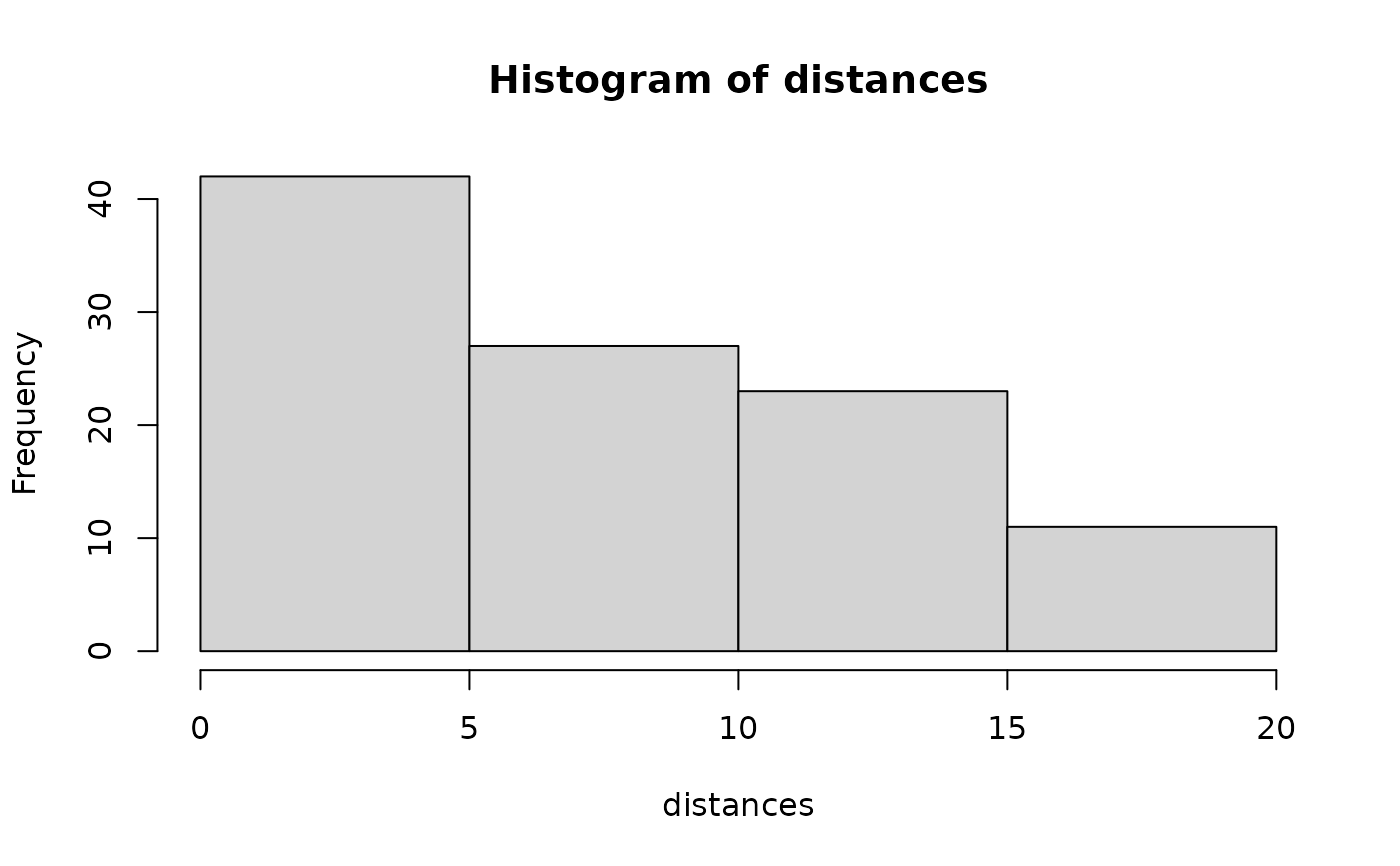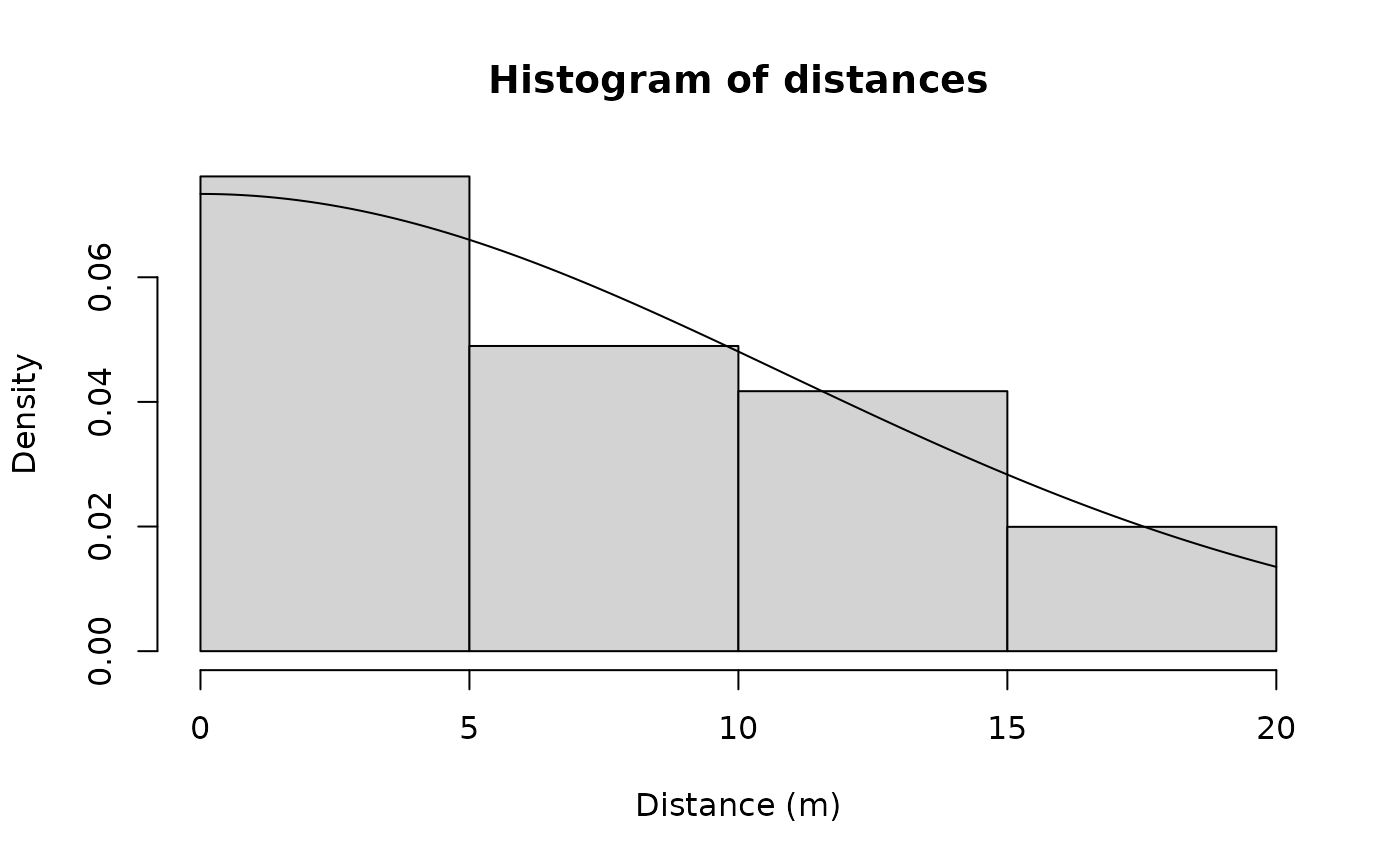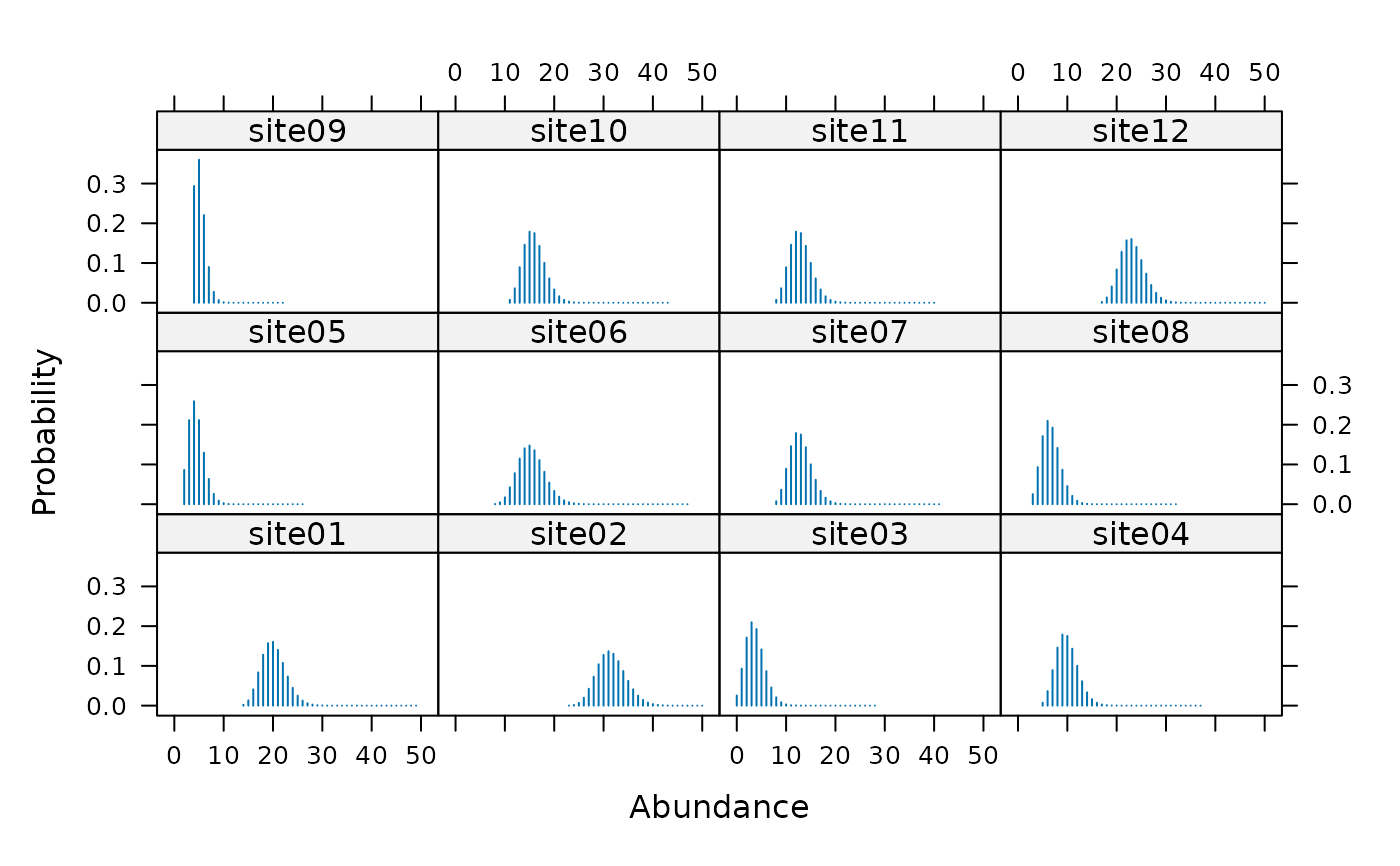Fit the hierarchical distance sampling model of Royle et al. (2004)
distsamp.RdFit the hierarchical distance sampling model of Royle et al. (2004) to line or point transect data recorded in discrete distance intervals.
Arguments
- formula
Double right-hand formula describing detection covariates followed by abundance covariates. ~1 ~1 would be a null model.
- data
object of class
unmarkedFrameDS, containing response matrix, covariates, distance interval cut points, survey type ("line" or "point"), transect lengths (for survey = "line"), and units ("m" or "km") for cut points and transect lengths. See example for set up.- keyfun
One of the following detection functions: "halfnorm", "hazard", "exp", or "uniform." See details.
- output
Model either "density" or "abund"
- unitsOut
Units of density. Either "ha" or "kmsq" for hectares and square kilometers, respectively.
- starts
Vector of starting values for parameters.
- method
Optimization method used by
optim.- se
logical specifying whether or not to compute standard errors.
- engine
Use code written in C++ or R
- rel.tol
Requested relative accuracy of the integral, see
integrate- ...
Additional arguments to optim, such as lower and upper bounds
Details
Unlike conventional distance sampling, which uses the 'conditional on detection' likelihood formulation, this model is based upon the unconditional likelihood and allows for modeling both abundance and detection function parameters.
The latent transect-level abundance distribution
\(f(N | \mathbf{\theta})\) assumed to be
Poisson with mean \(\lambda\) (but see gdistsamp
for alternatives).
The detection process is modeled as multinomial: \(y_{ij} \sim Multinomial(N_i, \pi_{ij})\), where \(\pi_{ij}\) is the multinomial cell probability for transect i in distance class j. These are computed based upon a detection function \(g(x | \mathbf{\sigma})\), such as the half-normal, negative exponential, or hazard rate.
Parameters \(\lambda\) and \(\sigma\) can be vectors affected by transect-specific covariates using the log link.
Value
unmarkedFitDS object (child class of unmarkedFit-class)
describing the model fit.
Note
You cannot use obsCovs.
References
Royle, J. A., D. K. Dawson, and S. Bates (2004) Modeling abundance effects in distance sampling. Ecology 85, pp. 1591-1597.
Sillett, S. and Chandler, R.B. and Royle, J.A. and Kery, M. and Morrison, S.A. In Press. Hierarchical distance sampling models to estimate population size and habitat-specific abundance of an island endemic. Ecological Applications
See also
unmarkedFrameDS,
unmarkedFit-class fitList,
formatDistData, parboot,
sight2perpdist, detFuns,
gdistsamp, ranef.
Also look at vignette("distsamp").
Examples
## Line transect examples
data(linetran)
ltUMF <- with(linetran, {
unmarkedFrameDS(y = cbind(dc1, dc2, dc3, dc4),
siteCovs = data.frame(Length, area, habitat),
dist.breaks = c(0, 5, 10, 15, 20),
tlength = linetran$Length * 1000, survey = "line", unitsIn = "m")
})
ltUMF
#> Data frame representation of unmarkedFrame object.
#> y.1 y.2 y.3 y.4 Length area habitat
#> 1 3 6 5 0 5 5.953128 A
#> 2 8 5 6 4 7 4.523539 A
#> 3 0 0 0 0 3 5.812511 A
#> 4 2 1 1 1 4 5.929066 A
#> 5 0 2 0 0 2 5.039786 A
#> 6 4 1 2 1 6 3.872571 A
#> 7 3 3 2 0 4 3.890749 B
#> 8 1 2 0 0 3 6.246779 B
#> 9 2 1 0 1 1 6.813926 B
#> 10 6 0 3 2 4 4.323164 B
#> 11 5 1 2 0 4 7.059182 B
#> 12 8 5 2 2 5 4.752804 B
summary(ltUMF)
#> unmarkedFrameDS Object
#>
#> line-transect survey design
#> Distance class cutpoints (m): 0 5 10 15 20
#>
#> 12 sites
#> Maximum number of distance classes per site: 4
#> Mean number of distance classes per site: 4
#> Sites with at least one detection: 11
#>
#> Tabulation of y observations:
#> 0 1 2 3 4 5 6 8
#> 14 9 10 4 2 4 3 2
#>
#> Site-level covariates:
#> Length area habitat
#> Min. :1 Min. :3.873 A:6
#> 1st Qu.:3 1st Qu.:4.473 B:6
#> Median :4 Median :5.426
#> Mean :4 Mean :5.351
#> 3rd Qu.:5 3rd Qu.:6.027
#> Max. :7 Max. :7.059
hist(ltUMF)
 # Half-normal detection function. Density output (log scale). No covariates.
(fm1 <- distsamp(~ 1 ~ 1, ltUMF))
#>
#> Call:
#> distsamp(formula = ~1 ~ 1, data = ltUMF)
#>
#> Density:
#> Estimate SE z P(>|z|)
#> -0.171 0.134 -1.28 0.201
#>
#> Detection:
#> Estimate SE z P(>|z|)
#> 2.39 0.127 18.7 2.46e-78
#>
#> AIC: 164.7524
# Some methods to use on fitted model
summary(fm1)
#>
#> Call:
#> distsamp(formula = ~1 ~ 1, data = ltUMF)
#>
#> Density (log-scale):
#> Estimate SE z P(>|z|)
#> -0.171 0.134 -1.28 0.201
#>
#> Detection (log-scale):
#> Estimate SE z P(>|z|)
#> 2.39 0.127 18.7 2.46e-78
#>
#> AIC: 164.7524
#> Number of sites: 12
#> optim convergence code: 0
#> optim iterations: 31
#> Bootstrap iterations: 0
#>
#> Survey design: line-transect
#> Detection function: halfnorm
#> UnitsIn: m
#> UnitsOut: ha
#>
backTransform(fm1, type="state") # animals / ha
#> Backtransformed linear combination(s) of Density estimate(s)
#>
#> Estimate SE LinComb (Intercept)
#> 0.843 0.113 -0.171 1
#>
#> Transformation: exp
exp(coef(fm1, type="state", altNames=TRUE)) # same
#> lam(Int)
#> 0.8427749
backTransform(fm1, type="det") # half-normal SD
#> Backtransformed linear combination(s) of Detection estimate(s)
#>
#> Estimate SE LinComb (Intercept)
#> 10.9 1.38 2.39 1
#>
#> Transformation: exp
hist(fm1, xlab="Distance (m)") # Only works when there are no det covars
# Half-normal detection function. Density output (log scale). No covariates.
(fm1 <- distsamp(~ 1 ~ 1, ltUMF))
#>
#> Call:
#> distsamp(formula = ~1 ~ 1, data = ltUMF)
#>
#> Density:
#> Estimate SE z P(>|z|)
#> -0.171 0.134 -1.28 0.201
#>
#> Detection:
#> Estimate SE z P(>|z|)
#> 2.39 0.127 18.7 2.46e-78
#>
#> AIC: 164.7524
# Some methods to use on fitted model
summary(fm1)
#>
#> Call:
#> distsamp(formula = ~1 ~ 1, data = ltUMF)
#>
#> Density (log-scale):
#> Estimate SE z P(>|z|)
#> -0.171 0.134 -1.28 0.201
#>
#> Detection (log-scale):
#> Estimate SE z P(>|z|)
#> 2.39 0.127 18.7 2.46e-78
#>
#> AIC: 164.7524
#> Number of sites: 12
#> optim convergence code: 0
#> optim iterations: 31
#> Bootstrap iterations: 0
#>
#> Survey design: line-transect
#> Detection function: halfnorm
#> UnitsIn: m
#> UnitsOut: ha
#>
backTransform(fm1, type="state") # animals / ha
#> Backtransformed linear combination(s) of Density estimate(s)
#>
#> Estimate SE LinComb (Intercept)
#> 0.843 0.113 -0.171 1
#>
#> Transformation: exp
exp(coef(fm1, type="state", altNames=TRUE)) # same
#> lam(Int)
#> 0.8427749
backTransform(fm1, type="det") # half-normal SD
#> Backtransformed linear combination(s) of Detection estimate(s)
#>
#> Estimate SE LinComb (Intercept)
#> 10.9 1.38 2.39 1
#>
#> Transformation: exp
hist(fm1, xlab="Distance (m)") # Only works when there are no det covars
 # Empirical Bayes estimates of posterior distribution for N_i
plot(ranef(fm1, K=50))
# Empirical Bayes estimates of posterior distribution for N_i
plot(ranef(fm1, K=50))
 # Effective strip half-width
(eshw <- integrate(gxhn, 0, 20, sigma=10.9)$value)
#> [1] 12.7523
# Detection probability
eshw / 20 # 20 is strip-width
#> [1] 0.6376152
# Halfnormal. Covariates affecting both density and and detection.
(fm2 <- distsamp(~area + habitat ~ habitat, ltUMF))
#>
#> Call:
#> distsamp(formula = ~area + habitat ~ habitat, data = ltUMF)
#>
#> Density:
#> Estimate SE z P(>|z|)
#> (Intercept) -0.376 0.191 -1.97 0.0490
#> habitatB 0.439 0.266 1.65 0.0992
#>
#> Detection:
#> Estimate SE z P(>|z|)
#> (Intercept) 3.091 0.5111 6.05 1.47e-09
#> area -0.110 0.0884 -1.24 2.14e-01
#> habitatB -0.271 0.2711 -1.00 3.17e-01
#>
#> AIC: 166.456
# Hazard-rate detection function.
(fm3 <- distsamp(~ 1 ~ 1, ltUMF, keyfun="hazard"))
#>
#> Call:
#> distsamp(formula = ~1 ~ 1, data = ltUMF, keyfun = "hazard")
#>
#> Density:
#> Estimate SE z P(>|z|)
#> -0.119 0.219 -0.546 0.585
#>
#> Detection:
#> Estimate SE z P(>|z|)
#> 2.13 0.433 4.91 9.34e-07
#>
#> Hazard-rate(scale):
#> Estimate SE z P(>|z|)
#> 0.315 0.543 0.58 0.562
#>
#> AIC: 167.0218
# Plot detection function.
fmhz.shape <- exp(coef(fm3, type="det"))
fmhz.scale <- exp(coef(fm3, type="scale"))
plot(function(x) gxhaz(x, shape=fmhz.shape, scale=fmhz.scale), 0, 25,
xlab="Distance (m)", ylab="Detection probability")
# Effective strip half-width
(eshw <- integrate(gxhn, 0, 20, sigma=10.9)$value)
#> [1] 12.7523
# Detection probability
eshw / 20 # 20 is strip-width
#> [1] 0.6376152
# Halfnormal. Covariates affecting both density and and detection.
(fm2 <- distsamp(~area + habitat ~ habitat, ltUMF))
#>
#> Call:
#> distsamp(formula = ~area + habitat ~ habitat, data = ltUMF)
#>
#> Density:
#> Estimate SE z P(>|z|)
#> (Intercept) -0.376 0.191 -1.97 0.0490
#> habitatB 0.439 0.266 1.65 0.0992
#>
#> Detection:
#> Estimate SE z P(>|z|)
#> (Intercept) 3.091 0.5111 6.05 1.47e-09
#> area -0.110 0.0884 -1.24 2.14e-01
#> habitatB -0.271 0.2711 -1.00 3.17e-01
#>
#> AIC: 166.456
# Hazard-rate detection function.
(fm3 <- distsamp(~ 1 ~ 1, ltUMF, keyfun="hazard"))
#>
#> Call:
#> distsamp(formula = ~1 ~ 1, data = ltUMF, keyfun = "hazard")
#>
#> Density:
#> Estimate SE z P(>|z|)
#> -0.119 0.219 -0.546 0.585
#>
#> Detection:
#> Estimate SE z P(>|z|)
#> 2.13 0.433 4.91 9.34e-07
#>
#> Hazard-rate(scale):
#> Estimate SE z P(>|z|)
#> 0.315 0.543 0.58 0.562
#>
#> AIC: 167.0218
# Plot detection function.
fmhz.shape <- exp(coef(fm3, type="det"))
fmhz.scale <- exp(coef(fm3, type="scale"))
plot(function(x) gxhaz(x, shape=fmhz.shape, scale=fmhz.scale), 0, 25,
xlab="Distance (m)", ylab="Detection probability")
 ## Point transect examples
# Analysis of the Island Scrub-jay data.
# See Sillett et al. (In press)
data(issj)
str(issj)
#> 'data.frame': 307 obs. of 8 variables:
#> $ issj[0-100] : int 0 0 0 0 0 0 0 0 0 0 ...
#> $ issj(100-200]: int 0 0 0 0 0 0 0 0 0 0 ...
#> $ issj(200-300]: int 2 0 0 0 0 0 0 0 0 0 ...
#> $ x : num 234870 237083 235732 237605 234239 ...
#> $ y : num 3767154 3766804 3766717 3766719 3766570 ...
#> $ elevation : num 51.4 156.9 144.8 184.3 111.4 ...
#> $ forest : num 0.022054 0.006731 0.016182 0.257626 0.000716 ...
#> $ chaparral : num 0.242 0.466 0.769 0.206 0 ...
jayumf <- unmarkedFrameDS(y=as.matrix(issj[,1:3]),
siteCovs=data.frame(scale(issj[,c("elevation","forest","chaparral")])),
dist.breaks=c(0,100,200,300), unitsIn="m", survey="point")
(fm1jay <- distsamp(~chaparral ~chaparral, jayumf))
#>
#> Call:
#> distsamp(formula = ~chaparral ~ chaparral, data = jayumf)
#>
#> Density:
#> Estimate SE z P(>|z|)
#> (Intercept) -2.799 0.160 -17.55 6.02e-69
#> chaparral 0.912 0.145 6.31 2.82e-10
#>
#> Detection:
#> Estimate SE z P(>|z|)
#> (Intercept) 4.729 0.0840 56.27 0.000000
#> chaparral -0.249 0.0739 -3.36 0.000772
#>
#> AIC: 969.9142
if (FALSE) { # \dontrun{
data(pointtran)
ptUMF <- with(pointtran, {
unmarkedFrameDS(y = cbind(dc1, dc2, dc3, dc4, dc5),
siteCovs = data.frame(area, habitat),
dist.breaks = seq(0, 25, by=5), survey = "point", unitsIn = "m")
})
# Half-normal.
(fmp1 <- distsamp(~ 1 ~ 1, ptUMF))
hist(fmp1, ylim=c(0, 0.07), xlab="Distance (m)")
# effective radius
sig <- exp(coef(fmp1, type="det"))
ea <- 2*pi * integrate(grhn, 0, 25, sigma=sig)$value # effective area
sqrt(ea / pi) # effective radius
# detection probability
ea / (pi*25^2)
} # }
## Point transect examples
# Analysis of the Island Scrub-jay data.
# See Sillett et al. (In press)
data(issj)
str(issj)
#> 'data.frame': 307 obs. of 8 variables:
#> $ issj[0-100] : int 0 0 0 0 0 0 0 0 0 0 ...
#> $ issj(100-200]: int 0 0 0 0 0 0 0 0 0 0 ...
#> $ issj(200-300]: int 2 0 0 0 0 0 0 0 0 0 ...
#> $ x : num 234870 237083 235732 237605 234239 ...
#> $ y : num 3767154 3766804 3766717 3766719 3766570 ...
#> $ elevation : num 51.4 156.9 144.8 184.3 111.4 ...
#> $ forest : num 0.022054 0.006731 0.016182 0.257626 0.000716 ...
#> $ chaparral : num 0.242 0.466 0.769 0.206 0 ...
jayumf <- unmarkedFrameDS(y=as.matrix(issj[,1:3]),
siteCovs=data.frame(scale(issj[,c("elevation","forest","chaparral")])),
dist.breaks=c(0,100,200,300), unitsIn="m", survey="point")
(fm1jay <- distsamp(~chaparral ~chaparral, jayumf))
#>
#> Call:
#> distsamp(formula = ~chaparral ~ chaparral, data = jayumf)
#>
#> Density:
#> Estimate SE z P(>|z|)
#> (Intercept) -2.799 0.160 -17.55 6.02e-69
#> chaparral 0.912 0.145 6.31 2.82e-10
#>
#> Detection:
#> Estimate SE z P(>|z|)
#> (Intercept) 4.729 0.0840 56.27 0.000000
#> chaparral -0.249 0.0739 -3.36 0.000772
#>
#> AIC: 969.9142
if (FALSE) { # \dontrun{
data(pointtran)
ptUMF <- with(pointtran, {
unmarkedFrameDS(y = cbind(dc1, dc2, dc3, dc4, dc5),
siteCovs = data.frame(area, habitat),
dist.breaks = seq(0, 25, by=5), survey = "point", unitsIn = "m")
})
# Half-normal.
(fmp1 <- distsamp(~ 1 ~ 1, ptUMF))
hist(fmp1, ylim=c(0, 0.07), xlab="Distance (m)")
# effective radius
sig <- exp(coef(fmp1, type="det"))
ea <- 2*pi * integrate(grhn, 0, 25, sigma=sig)$value # effective area
sqrt(ea / pi) # effective radius
# detection probability
ea / (pi*25^2)
} # }